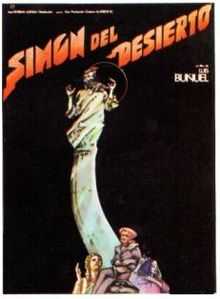Simon of the Desert
| Simon of the Desert | |
|---|---|
 Poster | |
| Directed by | Luis Buñuel |
| Produced by | Gustavo Alatriste |
| Written by |
Julio Alejandro Luis Buñuel |
| Starring |
Claudio Brook Silvia Pinal Enrique Álvarez Félix |
| Distributed by | Producciones Alatriste |
Release dates | 1965 (Mexico) |
Running time | 42 min. |
| Language | Spanish |
Simon of the Desert (Spanish: Simón del desierto) is a 1965 film directed by Luis Buñuel. It is loosely based on the story of the ascetic 5th-century Syrian saint Simeon Stylites, who lived for 39 years on top of a column.
Simon of the Desert is the third (after Viridiana and The Exterminating Angel) of three movies that were directed by Buñuel, starring Silvia Pinal and Claudio Brook and produced by her husband Gustavo Alatriste. Today it is generally acclaimed by film critics.
Synopsis
Simón, the son of Simeon Stylites, has lived for 6 years, 6 weeks and 6 days atop an eight-meter pillar in the middle of the desert, praying for spiritual purification. A congregation of priests and peasants salute him and offer him a brand new pillar to stand on and carry on his mission. He comes down from the pillar and is offered the priesthood, but refuses because he considers himself unworthy, and forsakes his aging mother for the love of God before climbing up his new pillar. He heals an amputee missing both hands, whose first use of them is to slap his child. But the congregation quickly departs unimpressed, leaving Simón alone.
Time goes by and Simón meets a number of regular characters – a handsome priest whom he condemns on grounds of vanity, a dwarf herder and his mother, who comes to live close to him but remains neglected of his attention. A woman (Silvia Pinal), Satan, visits him three times: first as an innocent girl chanting curses in Latin, second disguised as Jesus. She constantly tries to make Simón give up his task and climb down from the pillar, but he refuses every time. She even possesses one of the priests that visit him, who is consequently exorcised by the other priests.
The third time, a coffin trails across the desert and finally stops next to the pillar. It opens up to reveal Satan, clad in a toga, who at last climbs up the pillar and vanishes with Simón for good. In an anachronistic turn, the couple find themselves sitting inside a crowded, jumping 1960s nightclub with a live instrumental rock band on stage. Satan tells Simón that the song the 1960s hipsters are dancing to is called Radioactive Flesh. Simón protests about wanting to go home, but Satan says he cannot.[1]
Background
In 1960 Buñuel returned to his home country Spain after a long-term exile in Mexico in order to direct Viridiana.[2] The film scandalized the Vatican and the government, which prompted Buñuel into a second exile back to Mexico. There he directed The Exterminating Angel in 1962, and in the line of its predecessor, the film was critical of religion. Simón del desierto was the last of the trilogy starring Silvia Pinal and Claudio Brook (the latter usually in secondary roles) that controversially dealt with religion while retaining certain elements of Buñuel’s earlier surrealist period. The film was based on a novel of Buñuel, and was adapted by Buñuel and frequent collaborator Julio Alejandro.
Anecdotes
The Mexican actress Silvia Pinal revealed: "It is not true that Simon of the Desert was just an average footage showing Alatriste's economic troubles. It was a production trouble. There are three stories with different directors. Buñuel was one. Alatriste and I went to Europe to seek Federico Fellini, who had filmed and was delighted with Buñuel, but suggested his wife Giulietta Masina as the star. We saw another director, Jules Dassin, who had also filmed his wife Melina Mercouri as the star. We don't accept that, because the three stories were starred by me. So, because everyone wanted to direct their wives, Alatriste wanted to direct his own part with his wife, and with me. Alatriste would not understand that he could not direct with Buñuel."[3]
Reception
Simon of the Desert has received much acclaim since its original release; Rotten Tomatoes reports 100% approval among 15 critics, with an average rating of 8.5/10.[4]
Cultural references
The video clip for the song The Laws Have Changed from The New Pornographers’ 2003 album Electric Version heavily references the conclusion of the film, with a Simón-like figure lured from his pillar to a nightclub where the song is being played.
The music video for Beck's song "Loser" depicts a coffin moving around by itself, similar to the coffin containing Satan in Simon of the Desert.
References
- ↑ Richard P Krafsur: The American Film Institute catalog of motion pictures produced in the United States: feature films, 1961-1970, page 989.
- ↑ Film: A Modern Art, page 245.
- ↑ García Riera, Emilio. El cine de Silvia Pinal (Cinema of Silvia Pinal), México, 1996, Universidad de Guadalajara (CIEC), Patronato de la Muestra de Cine Mexicano en Guadalajara, A. C. e Instituto Mexicano de Cinematografía (IMCINE), p.108
- ↑ "Simon of the Desert on RT". Rotten Tomatoes. Retrieved April 7, 2015.
External links
| Awards | ||
|---|---|---|
| Preceded by The Gospel According to St. Matthew tied with Hamlet |
Special Jury Prize, Venice 1965 tied with I am Twenty and Modiga Mindre Män |
Succeeded by Yesterday Girl tied with Chappaqua |